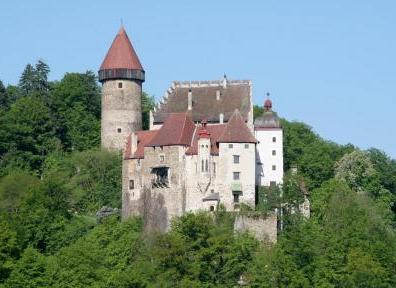

Location: Upper Austria Map
Constructed: 12th century
Clam Castle is a large medieval stronghold in Upper Austria region of Austria. Clam Castle was constructed in the middle of the 12th century. It overlooks a strategic valley of Danube River that flows below. Clam Castle or Burg Clam is one of the few citadels in the region that remained virtually unchanged since its construction.
Clam Castle was first mentioned in a document in 1142. At that time
it was owned by Walchun, the brother of Otto von Machland from the
Perg-Machland noble family. A supposedly older mention of Clam Castle
can be found in a document from the Gleink monastery, which is dated
1125. But this document is most likely a forgery from the 13th century.
With Walchun's heiress Adelheid, the castle became the property of the
Velburg family and, with the death of Ulrich von Clam-Velburg in the
Damiette Crusade in 1217, fell to the sovereign, as did Klingenberg
Castle. At that time, a second castle was also mentioned in Klam, of
which the remains of the fortifications on the opposite hilltop, the
so-called Schwedenschanze Achatzberg, could testify.
From
1234 to 1324 the Holzer and from 1250 to 1413 the Hauser appear as fief
bearers of Clam. According to Wilhelm dem Hauser, Christian and
Christoph von Zinzendorf may have been the owners. From 1416 Gilg,
Ortaker, Gilg and Wolfgang Wolfstein first owned the castle, after
Wolfgang's death it passed to Jörg Seusenecker and then to Prüschenk and
from 1454 to the Counts of Hardegg.
In 1524, Christoph Perger
bought “Castle and Veste Clam together with the tower” from the Counts
of Hardegg. After Christoph Perger I. came Christoph Perger II., his son
Hanns Enoch Perger and Johann Gottfried Perger.
Johann Gottfried
Perger
Johann Gottfried Perger zu Clam (1598-1673) was considered the
greatest supporter of the market town of Klam and its citizens. He had
the castle extensively renovated from 1640, which is why he is still
considered a "restorer familiae". His wife, Sibylle Countess von
Kagenek, was also not idle: she gave birth to 12 children and had
enormous assets from the Kagenek family. Johann Gottfried Perger had the
market's old freedoms confirmed, the church in Hofkirchen renovated in
1641 and the local church built in 1659. He donated the hospital and the
herb fields. In 1640 Emperor Ferdinand III. was awarded the title "Edle
Herr zu Clam" and in 1655 he was raised to the rank of baron. In the
same year, Johann Gottfried Perger converted to the Catholic faith.
Outerstein Castle has also belonged to Clam Castle since 1665.
Clam Martinic
In 1759, Empress Maria Theresa bestowed the title of
Hereditary Austrian Count on the family. The Clam family was divided
into the Clam-Clam, Clam-Gallas and Clam-Martinic lines. After the
Clam-Clam family died out in 1815, the Clam-Martinic family, who had
significant estates in Bohemia, took over the old family estate. Clam
Castle is inhabited all year round by the (former count) family. Today's
lord of the castle is Carl Philip Clam-Martinic. The most important
members of the family were Heinrich Clam-Martinic, Austrian prime
minister and military officer, Heinrich Jaroslav Count Clam-Martinic,
Bohemian politician, and Georg Clam Martinic, Austrian engineer, farmer,
author and monument conservator.
The castle complex is a castle inhabited by the owners all year
round. Clam Castle was fundamentally rebuilt by the Hauser family in the
14th century, so that today nothing remains of the original
fortifications from the 12th century. The oldest part of Clam Castle
that is still visible today is the higher round tower built in the 13th
century.
Through an outer bailey with a large, irregular
courtyard formed by administration buildings, garages and the Palas, a
wrought-iron gate leads to the castle courtyard, which is bordered by a
stone balustrade and surrounded by arcades. The rock on which the castle
was built reaches up to the first floor. From the courtyard, sgraffiti
can be seen on the wall of the palace. The ensemble is completed by a
keep with a conical roof, located a little to the side of the castle.
The castle has been in the same family for around half a millennium
and has never been destroyed. This is the reason why many furnishings
and a large number of historical gems have been preserved.
In the
castle there is a St. Chapel consecrated to the cross and another chapel
from the 14th century rediscovered in 1934 on the fourth floor of the
palace.
Accessible sights of the castle include the three-story arcaded
courtyard, the armory with armor used to defend the castle, the Gothic
castle chapel built in 1422, the castle pharmacy with a medicine chest
from 1603, and the living quarters of the Counts of Clam, including the
breakfast room with a porcelain collection and several sumptuously
furnished guest rooms, the master's kitchen, a music room and a large
set banquet table in the landscape room.
Todays use
Next to
the actual castle complex there is a castle brewery and a Meierhof. The
riding hall and riding arena of the castle are operated by the Burg Clam
riding club. Since 1990, the clam concerts with internationally renowned
musicians have taken place in the brewery garden and on the
Meierhofwiese.
In 1923, Heinrich Clam-Martinic had an electricity
plant built in the Klam Gorge. The residents of the communities of Klam,
Saxen, Baumgartenberg and Mitterkirchen im Machland were supplied with
electricity. Georg Clam-Martinic had another power station built in
1963, for which the hammer mill was demolished and the Bergmayr mill and
sawmill ceased operations.